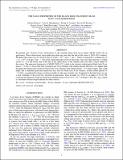THE X-RAY PROPERTIES OF THE BLACK HOLE TRANSIENT MAXI J1659-152 IN QUIESCENCE
Author(s)
Homan, Jeroen; Fridriksson, Joel K.; Jonker, P. G.; Russell, David M.; Gallo, Elena; Kuulkers, Erik; Rea, Nanda; Altamirano, Diego; ... Show more Show less
DownloadHoman-2013-The x-ray properties.pdf (445.1Kb)
PUBLISHER_POLICY
Publisher Policy
Article is made available in accordance with the publisher's policy and may be subject to US copyright law. Please refer to the publisher's site for terms of use.
Terms of use
Metadata
Show full item recordAbstract
We present new Chandra X-ray observations of the transient black hole X-ray binary MAXI J1659-152 in quiescence. These observations were made more than one year after the end of the source's 2010-2011 outburst. We detect the source at a 0.5-10 keV flux of 2.8(8) × 10[superscript –15] erg s[superscript –1] cm[superscript –2], which corresponds to a luminosity of ~1.2 × 10[superscript 31] (d/6 kpc)[superscript 2] erg s[superscript –1]. This level, while being the lowest at which the source has been detected, is within factors of ~2 of the levels seen at the end of the initial decay of the outburst and soon after a major reflare of the source. The quiescent luminosity of MAXI J1659-152, which is the shortest-orbital-period black hole X-ray binary (~2.4 hr), is lower than that of neutron-star X-ray binaries with similar periods. However, it is higher than the quiescent luminosities found for black hole X-ray binaries with orbital periods ~2-4 times longer. This could imply that a minimum quiescent luminosity may exist for black hole X-ray binaries, around orbital periods of ~5-10 hr, as predicted by binary-evolution models for the mass transfer rate. Compared to the hard state, we see a clear softening of the power-law spectrum in quiescence, from an index of 1.55(4) to an index of 2.5(4). We constrain the luminosity range in which this softening starts to (0.18-6.2) × 10[superscript –5] (d/6 kpc)[superscript 2] (M/8 M ☉) L [subscript Edd], which is consistent with the ranges inferred for other sources.
Date issued
2013-09Department
MIT Kavli Institute for Astrophysics and Space ResearchJournal
Astrophysical Journal
Publisher
Institute of Physics/American Astronomical Society
Citation
Homan, Jeroen, Joel K. Fridriksson, Peter G. Jonker, David M. Russell, Elena Gallo, Erik Kuulkers, Nanda Rea, and Diego Altamirano. “THE X-RAY PROPERTIES OF THE BLACK HOLE TRANSIENT MAXI J1659-152 IN QUIESCENCE.” The Astrophysical Journal 775, no. 1 (August 28, 2013): 9. ©2013 American Astronomical Society.
Version: Final published version
ISSN
0004-637X
1538-4357